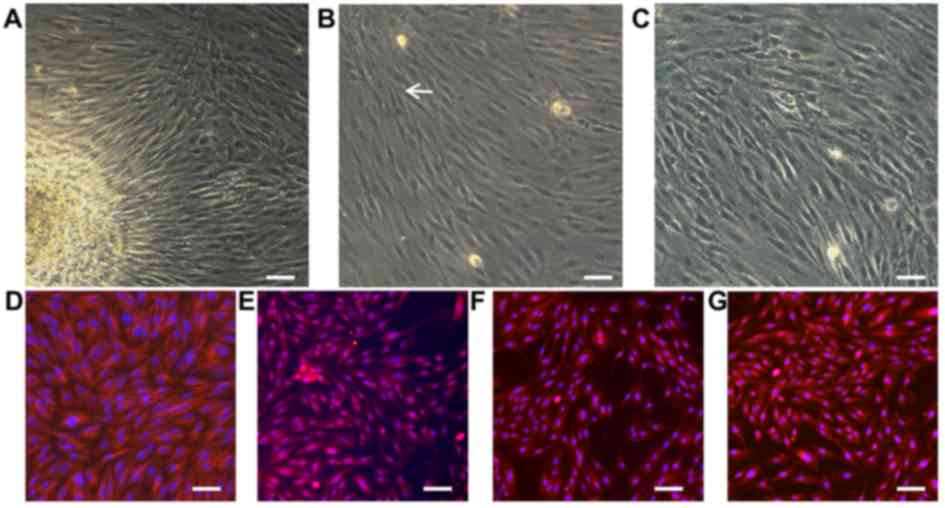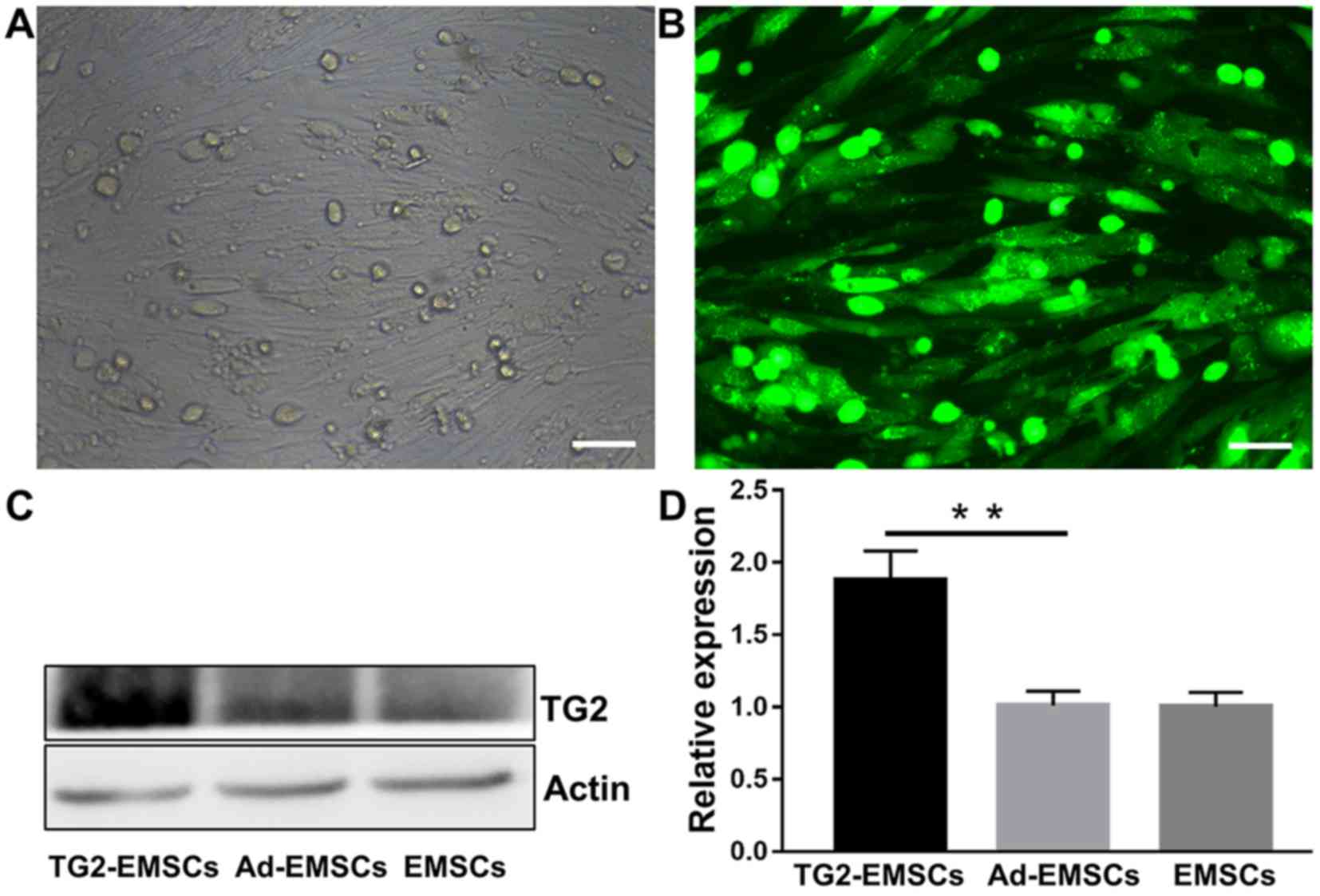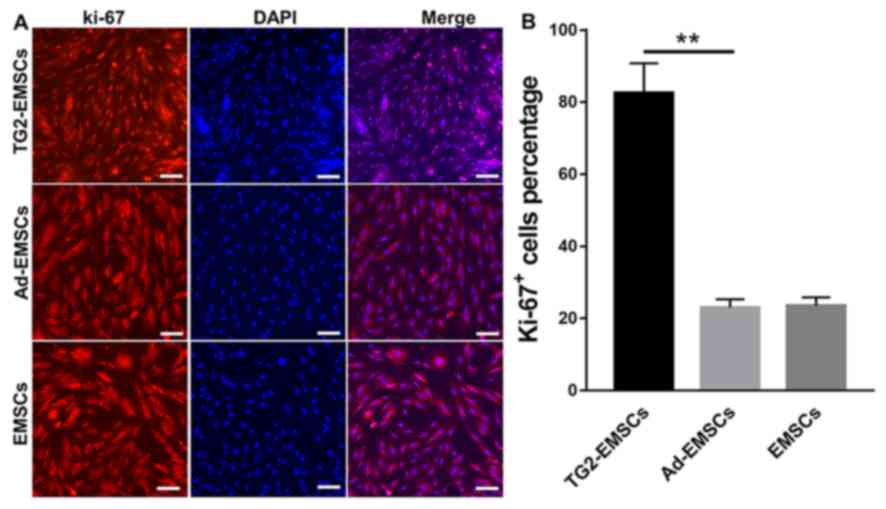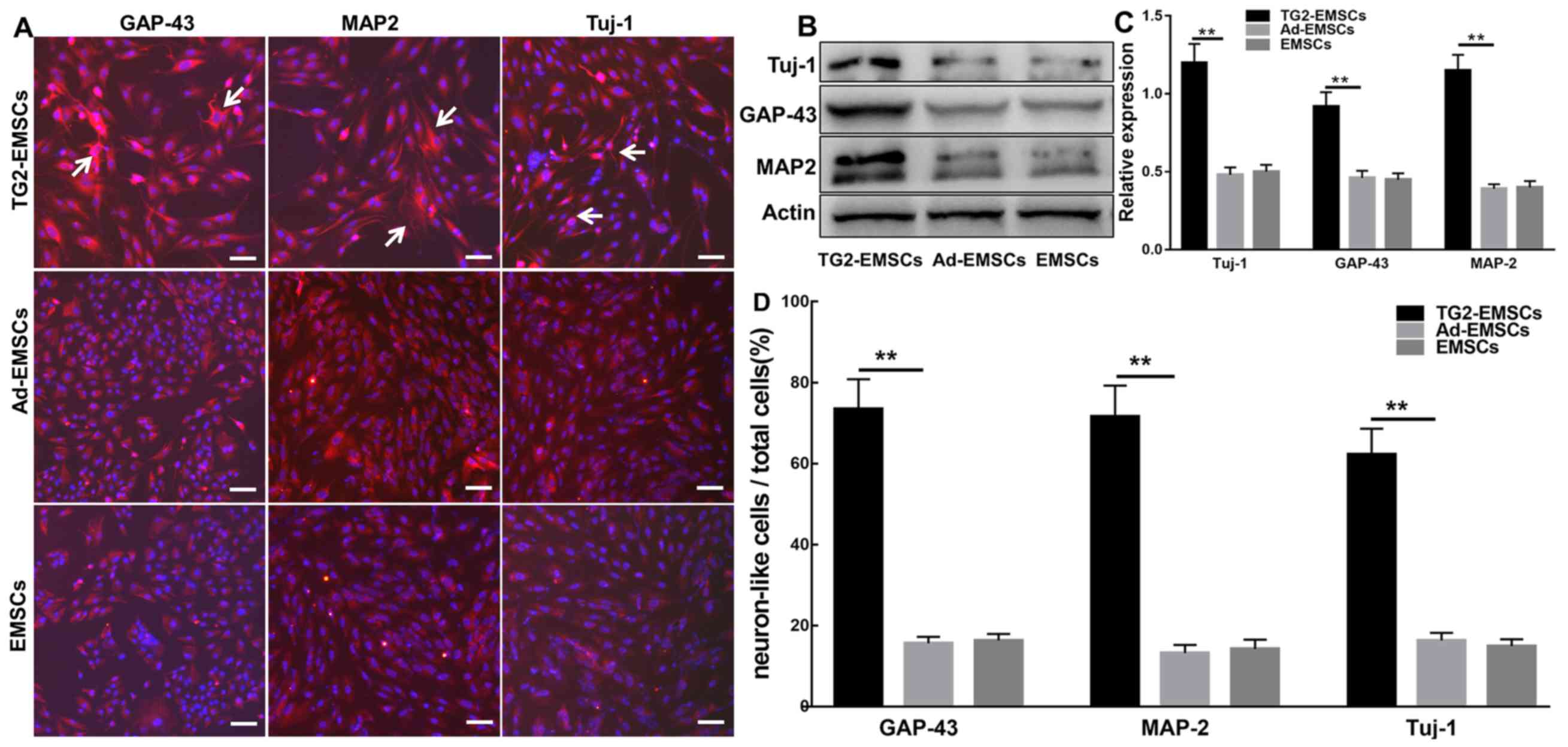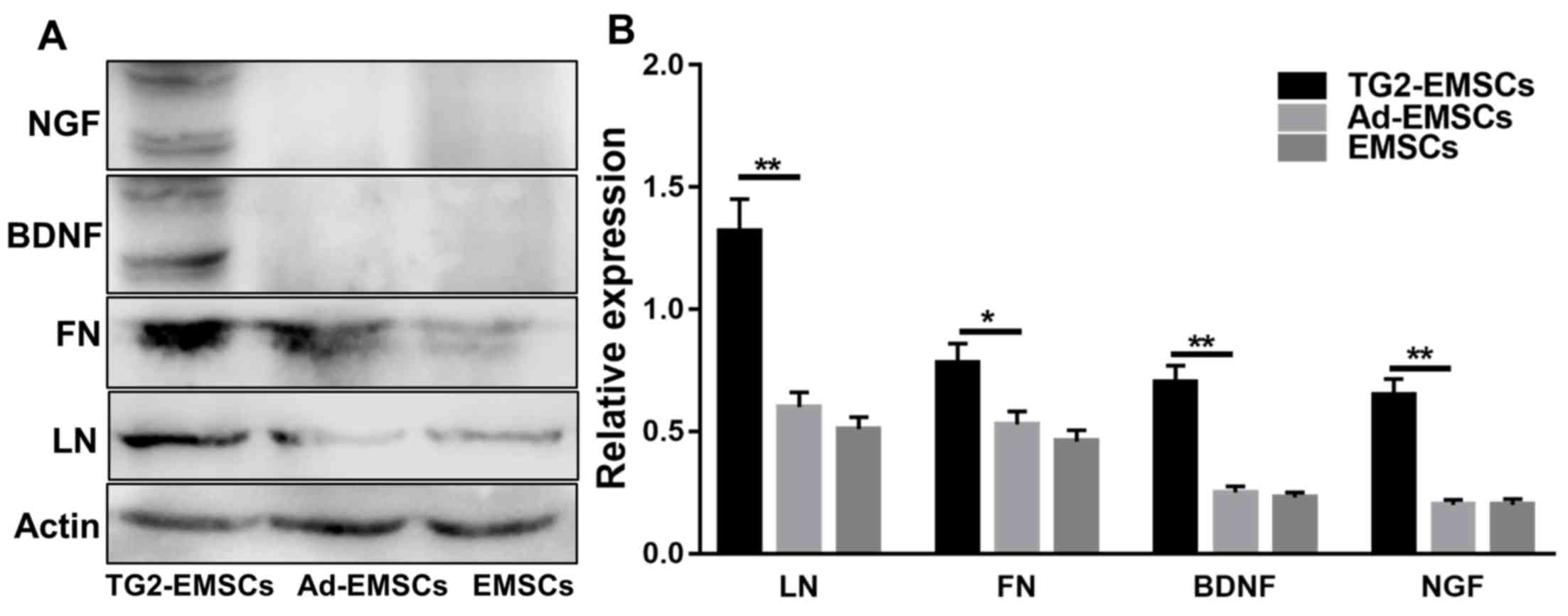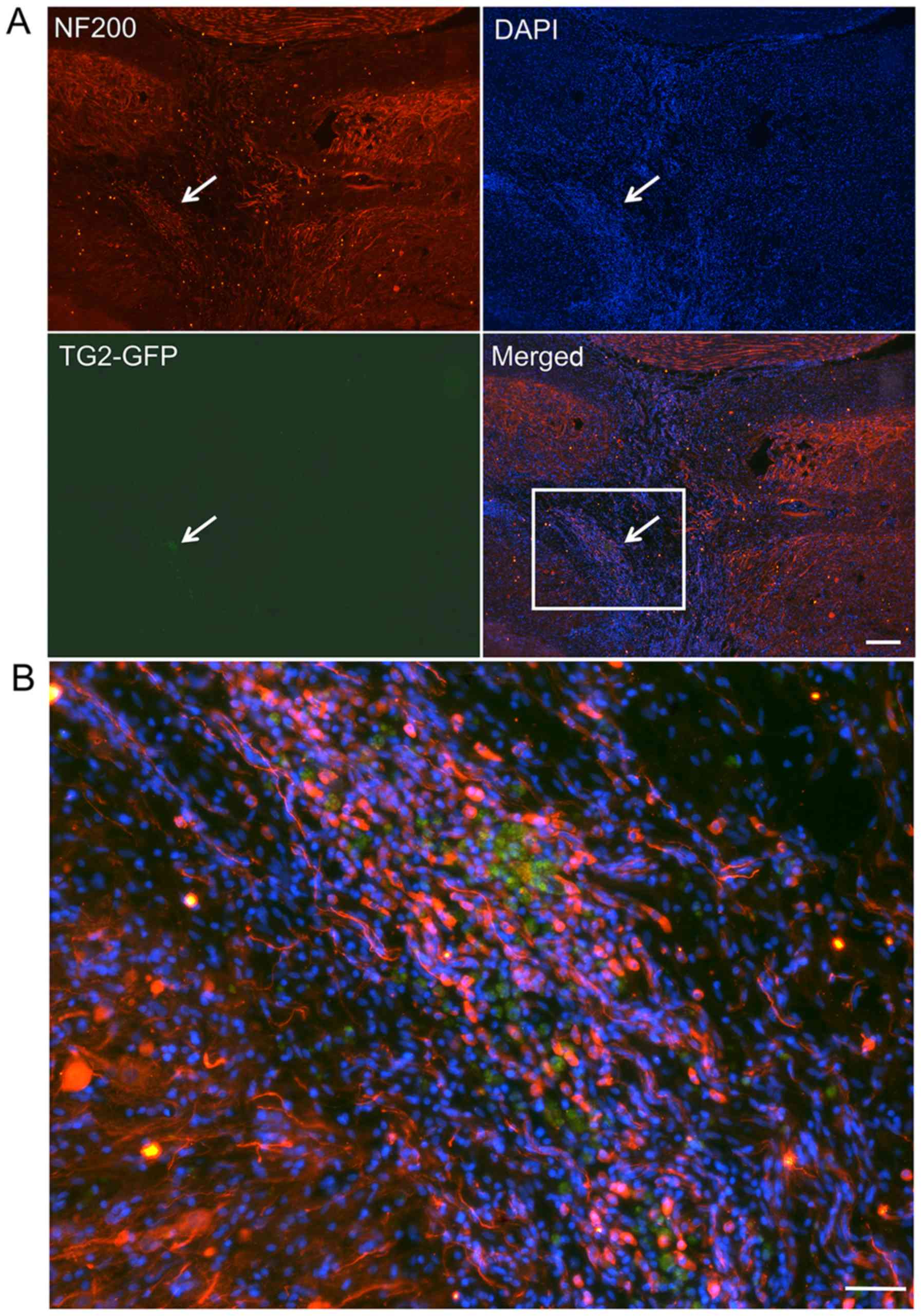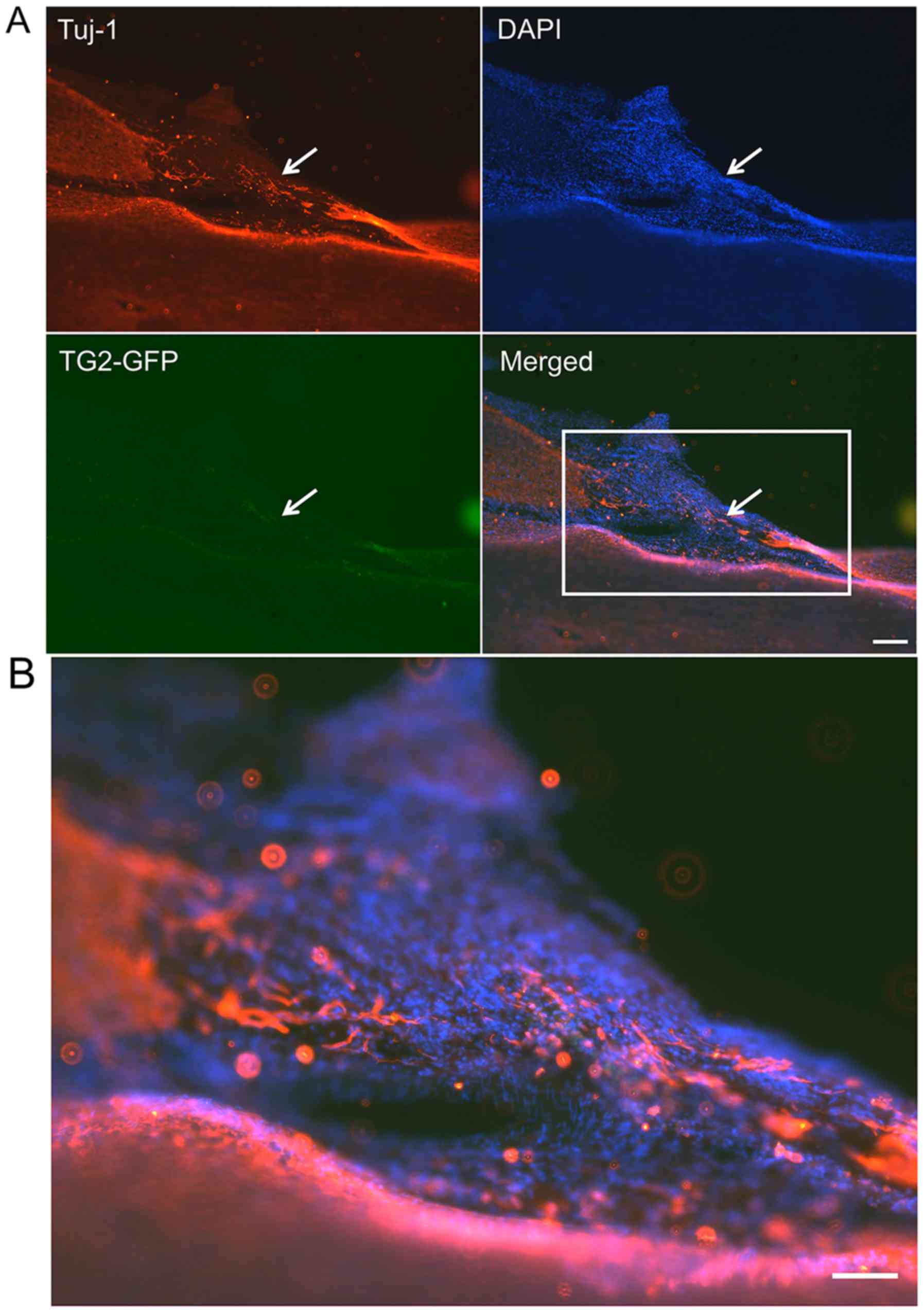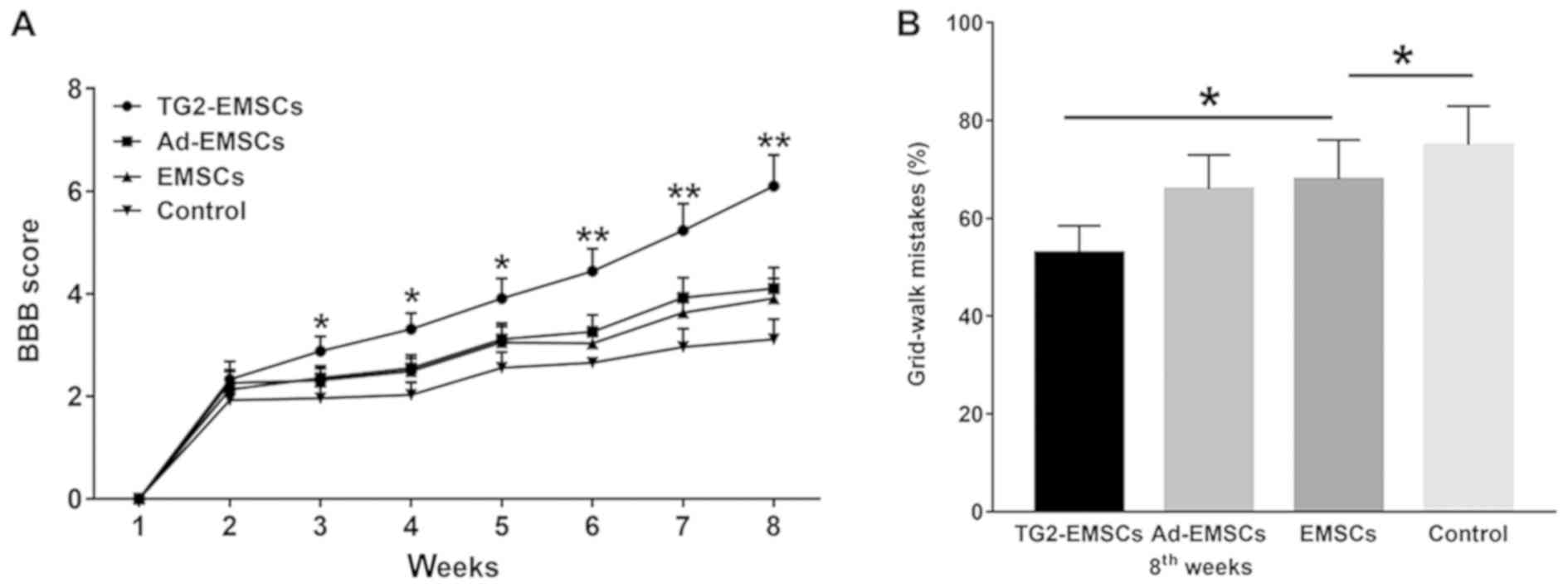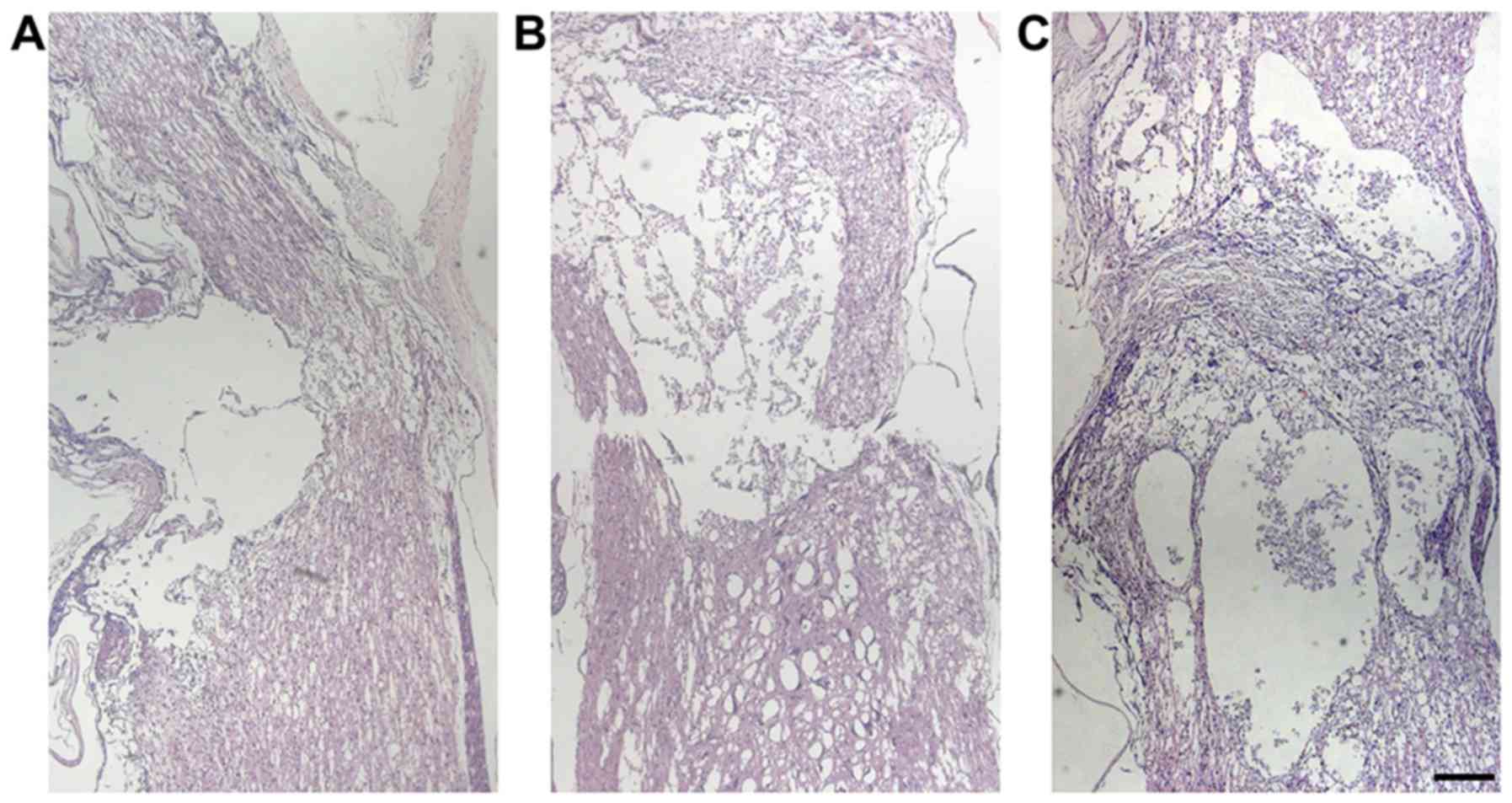|
1
|
Jin MC, Medress ZA, Azad TD, Doulames VM
and Veeravagu A: Stem cell therapies for acute spinal cord injury
in humans: A review. Neurosurgical Focus. 46:E102019. View Article : Google Scholar : PubMed/NCBI
|
|
2
|
Konig N, Trolle C, Kapuralin K, Adameyko
I, Mitrecic D, Aldskogius H, Shortland PJ and Kozlova EN: Murine
neural crest stem cells and embryonic stem cell-derived neuron
precursors survive and differentiate after transplantation in a
model of dorsal root avulsion. J Tissue Eng Regen Med. 11:129–137.
2017. View Article : Google Scholar : PubMed/NCBI
|
|
3
|
Richardson SM, Kalamegam G, Pushparaj PN,
Matta C, Memic A, Khademhosseini A, Mobasheri R, Poletti FL,
Hoyland JA and Mobasheri A: Mesenchymal stem cells in regenerative
medicine: Focus on articular cartilage and intervertebral disc
regeneration. Methods. 99:69–80. 2016. View Article : Google Scholar : PubMed/NCBI
|
|
4
|
Zhang Z, He Q, Deng W, Chen Q, Hu X, Gong
A, Cao X, Yu J and Xu X: Nasal ectomesenchymal stem cells:
Multi-lineage differentiation and transformation effects on fibrin
gels. Biomaterials. 49:57–67. 2015. View Article : Google Scholar : PubMed/NCBI
|
|
5
|
Liu J, Chen Q, Zhang Z, Zheng Y, Sun X,
Cao X, Gong A, Cui Y, He Q and Jiang P: Fibrin scaffolds containing
ectomesenchymal stem cells enhance behavioral and histological
improvement in a rat model of spinal cord injury. Cells Tissues
Organs. 198:35–46. 2013. View Article : Google Scholar : PubMed/NCBI
|
|
6
|
Zhang J, Gao X, Zou H, Liu J and Zhang Z:
Rat nasal respiratory mucosa-derived ectomesenchymal stem cells
differentiate into schwann-like cells promoting the differentiation
of PC12 cells and forming myelin in vitro. Stem Cells Int.
2015:3289572015. View Article : Google Scholar : PubMed/NCBI
|
|
7
|
Abdallah B and Kassem M: Human mesenchymal
stem cells: From basic biology to clinical applications. Gene Ther.
15:109–116. 2008. View Article : Google Scholar : PubMed/NCBI
|
|
8
|
Sahni V and Kessler JA: Stem cell
therapies for spinal cord injury. Nat Rev Neurol. 6:363–372. 2010.
View Article : Google Scholar : PubMed/NCBI
|
|
9
|
Badarau E, Collighan RJ and Griffin M:
Recent advances in the development of tissue transglutaminase (TG2)
inhibitors. Amino Acids. 44:119–127. 2013. View Article : Google Scholar : PubMed/NCBI
|
|
10
|
Belkin AM: Extracellular TG2: Emerging
functions and regulation. FEBS J. 278:4704–4716. 2011. View Article : Google Scholar : PubMed/NCBI
|
|
11
|
Zemskov EA, Janiak A, Hang J, Waghray A
and Belkin AM: The role of tissue transglutaminase in cell-matrix
interactions. Front Biosci. 11:1057–1076. 2006. View Article : Google Scholar : PubMed/NCBI
|
|
12
|
Collighan RJ and Griffin M:
Transglutaminase 2 cross-linking of matrix proteins: Biological
significance and medical applications. Amino Acids. 36:659–670.
2009. View Article : Google Scholar : PubMed/NCBI
|
|
13
|
Kanchan K, Fuxreiter M and Fésüs L:
Physiological, pathological, and structural implications of
non-enzymatic protein-protein interactions of the multifunctional
human transglutaminase 2. Cell Mol Life Sci. 72:3009–3035. 2015.
View Article : Google Scholar : PubMed/NCBI
|
|
14
|
Lorand L and Graham RM: Transglutaminases:
Crosslinking enzymes with pleiotropic functions. Nat Rev Mol Cell
Biol. 4:140–156. 2003. View
Article : Google Scholar : PubMed/NCBI
|
|
15
|
Soluri MF, Boccafoschi F, Cotella D, Moro
L, Forestieri G, Autiero I, Cavallo L, Oliva R, Griffin M, Wang Z,
et al: Mapping the minimum domain of the fibronectin binding site
on transglutaminase 2 (TG2) and its importance in mediating
signaling, adhesion, and migration in TG2-expressing cells. FASEB
J. 33:2327–2342. 2019. View Article : Google Scholar : PubMed/NCBI
|
|
16
|
Tucholski J: TG2 protects neuroblastoma
cells against DNA-damage-induced stress, suppresses p53 activation.
Amino Acids. 39:523–532. 2010. View Article : Google Scholar : PubMed/NCBI
|
|
17
|
Van Strien ME, Drukarch B, Bol JG, van der
Valk P, van Horssen J, Gerritsen WH, Breve JJ and van Dam AM:
Appearance of tissue transglutaminase in astrocytes in multiple
sclerosis lesions: A role in cell adhesion and migration? Brain
Pathol. 21:44–54. 2011. View Article : Google Scholar : PubMed/NCBI
|
|
18
|
Pitolli C, Pietroni V, Marekov L,
Terrinoni A, Yamanishi K, Mazzanti C, Melino G and Candi E:
Characterization of TG2 and TG1-TG2 double knock-out mouse
epidermis. Amino Acids. 49:635–642. 2017. View Article : Google Scholar : PubMed/NCBI
|
|
19
|
Ginn SL, Amaya AK, Alexander IE, Edelstein
M and Abedi MR: Gene therapy clinical trials worldwide to 2017: An
update. J Gene Med. 20:e30152018. View
Article : Google Scholar : PubMed/NCBI
|
|
20
|
Qu Y, Zhao J, Wang Y and Gao Z: Silencing
ephrinB3 improves functional recovery following spinal cord injury.
Mol Med Rep. 9:1761–1766. 2014. View Article : Google Scholar : PubMed/NCBI
|
|
21
|
Ribault A, Loinard C, Flamant S, Lim S and
Tamarat R: Exosomes derived from human mesenchymal stromal cells
promote wound healing in a mouse model of radiation-induced injury.
Cytotherapy. 20:e2–e3. 2018. View Article : Google Scholar
|
|
22
|
Yuan X, Wu Q, Wang P, Jing Y, Yao H, Tang
Y, Han R, He W, Li Z, Zhang H and Xiu R: Intraspinal administration
of interleukin-7 promotes neuronal apoptosis and limits functional
recovery through JAK/STAT5 pathway following spinal cord injury.
Biochem Biophys Res Commun. 514:1023–1029. 2019. View Article : Google Scholar : PubMed/NCBI
|
|
23
|
Caglar YS, Demirel A, Dogan I, Huseynov R,
Eroglu U, Ozgural O, Cansiz C, Bahadir B, Kilinc MC and Al-Beyati
ESM: Effect of riluzole on spinal cord regeneration with
hemisection method before injury. World Neurosurg. 114:e247–e253.
2018. View Article : Google Scholar : PubMed/NCBI
|
|
24
|
Chen Q, Zhang Z, Liu J, He Q, Zhou Y, Shao
G, Sun X, Cao X, Gong A and Jiang P: A fibrin matrix promotes the
differentiation of EMSCs isolated from nasal respiratory mucosa to
myelinating phenotypical schwann-like cells. Mol Cells. 38:221–228.
2015.PubMed/NCBI
|
|
25
|
Deng W, Shao F, He Q, Wang Q, Shi W, Yu Q,
Cao X, Feng C, Bi S, Chen J, et al: EMSCs Build an All-in-One niche
via cell-cell lipid raft assembly for promoted neuronal but
suppressed astroglial differentiation of neural stem cells. Adv
Mater. 31:e18068612019. View Article : Google Scholar : PubMed/NCBI
|
|
26
|
Egawa N, Lok J, Washida K and Arai K:
Mechanisms of axonal damage and repair after central nervous system
injury. Transl Stroke Res. 8:14–21. 2017. View Article : Google Scholar : PubMed/NCBI
|
|
27
|
Sun Y, Wu H, Chen G, Huang X, Shan Y, Shi
H, Zhang Q and Zheng Y: Genetically engineered recombinant
adenovirus expressing interleukin-2 for hepatocellular carcinoma
therapy. Mol Med Rep. 17:300–306. 2018.PubMed/NCBI
|
|
28
|
Sandner B, Ciatipis M, Motsch M, Soljanik
I, Weidner N and Blesch A: Limited functional effects of subacute
syngeneic bone marrow stromal cell transplantation after rat spinal
cord contusion injury. Cell Transplant. 25:125–139. 2016.
View Article : Google Scholar : PubMed/NCBI
|
|
29
|
Li J, Guo W, Xiong M, Zhang S, Han H, Chen
J, Mao D, Yu H and Zeng Y: Erythropoietin facilitates the
recruitment of bone marrow mesenchymal stem cells to sites of
spinal cord injury. Exp Ther Med. 13:1806–1812. 2017. View Article : Google Scholar : PubMed/NCBI
|
|
30
|
Ibarretxe G, Crende O, Aurrekoetxea M,
García-Murga V, Etxaniz J and Unda F: Neural crest stem cells from
dental tissues: A new hope for dental and neural regeneration. Stem
Cells Int. 2012:1035032012. View Article : Google Scholar : PubMed/NCBI
|
|
31
|
Zhang Z, Li Z, Deng W, He Q, Wang Q, Shi
W, Chen Q, Yang W, Spector M, Gong A, et al: Ectoderm mesenchymal
stem cells promote differentiation and maturation of
oligodendrocyte precursor cells. Biochem Biophys Res Commun.
480:727–733. 2016. View Article : Google Scholar : PubMed/NCBI
|
|
32
|
Vanella L, Raciti G, Barbagallo I,
Bonfanti R, Abraham N and Campisi A: Tissue transglutaminase
expression during neural differentiation of human mesenchymal stem
cells. CNS Neurol Disord Drug Targets. 14:24–32. 2015. View Article : Google Scholar : PubMed/NCBI
|
|
33
|
Hung CC, Lin CH, Chang H, Wang CY, Lin SH,
Hsu PC, Sun YY, Lin TN, Shie FS, Kao LS, et al: Astrocytic GAP43
induced by the TLR4/NF-κB/STAT3 axis attenuates
astrogliosis-mediated microglial activation and neurotoxicity. J
Neurosci. 36:2027–2043. 2016. View Article : Google Scholar : PubMed/NCBI
|
|
34
|
Locatelli F, Corti S, Donadoni C, Guglieri
M, Capra F, Strazzer S, Salani S, Del Bo R, Fortunato F, Bordoni A
and Comi GP: Neuronal differentiation of murine bone marrow Thy-1-
and Sca-1-positive cells. J Hematother Stem Cell Res. 12:727–734.
2003. View Article : Google Scholar : PubMed/NCBI
|
|
35
|
Stephens P, Grenard P, Aeschlimann P,
Langley M, Blain E, Errington R, Kipling D, Thomas D and
Aeschlimann D: Crosslinking and G-protein functions of
transglutaminase 2 contribute differentially to fibroblast wound
healing responses. J Cell Sci. 117:3389–3403. 2004. View Article : Google Scholar : PubMed/NCBI
|
|
36
|
Nelea V, Nakano Y and Kaartinen MT: Size
distribution and molecular associations of plasma fibronectin and
fibronectin crosslinked by transglutaminase 2. Protein J.
27:223–233. 2008. View Article : Google Scholar : PubMed/NCBI
|
|
37
|
Chau DY, Brown SV, Mather ML, Hutter V,
Tint NL, Dua HS, Rose FR and Ghaemmaghami AM: Tissue
transglutaminase (TG-2) modified amniotic membrane: A novel
scaffold for biomedical applications. Biomed Mater. 7:0450112012.
View Article : Google Scholar : PubMed/NCBI
|
|
38
|
Pavlyukov MS, Antipova NV, Balashova MV
and Shakhparonov MI: Detection of transglutaminase 2 conformational
changes in living cell. Biochem Biophys Res Commun. 421:773–779.
2012. View Article : Google Scholar : PubMed/NCBI
|
|
39
|
Li J, Li X, Jing Z, Kawazoe N and Chen G:
Induction of chondrogenic differentiation of human mesenchymal stem
cells by biomimetic gold nanoparticles with tunable RGD density.
Adv Healthc Mater. 62017.doi: 10.1002/adhm.201700317.
|
|
40
|
Pollock K, Dahlenburg H, Nelson H, Fink
KD, Cary W, Hendrix K, Annett G, Torrest A, Deng P, Gutierrez J, et
al: Human mesenchymal stem cells genetically engineered to
overexpress brain-derived neurotrophic factor improve outcomes in
huntington's disease mouse models. Mol Ther. 24:965–977. 2016.
View Article : Google Scholar : PubMed/NCBI
|
|
41
|
Barde YA, Edgar D and Thoenen H:
Purification of a new neurotrophic factor from mammalian brain.
EMBO J. 1:549–553. 1982. View Article : Google Scholar : PubMed/NCBI
|
|
42
|
Jia Y, Wu D, Zhang R, Shuang W, Sun J, Hao
H, An Q and Liu Q: Bone marrow-derived mesenchymal stem cells
expressing the Shh transgene promotes functional recovery after
spinal cord injury in rats. Neurosci Lett. 573:46–51. 2014.
View Article : Google Scholar : PubMed/NCBI
|
|
43
|
Mifflin KA, Frieser E, Benson C, Baker G
and Kerr BJ: Voluntary wheel running differentially affects disease
outcomes in male and female mice with experimental autoimmune
encephalomyelitis. J Neuroimmunol. 305:135–144. 2017. View Article : Google Scholar : PubMed/NCBI
|
|
44
|
Jambrovics K, Uray IP, Keressztesy Z,
Keillor JW, Fésüs L and Balajthy Z: Transglutaminase 2 programs
differentiating acute promyelocytic leukemia cells in all-trans
retinoic acid treatment to inflammatory stage through NF-kB
activation. Haematologica. 104:505–515. 2019. View Article : Google Scholar : PubMed/NCBI
|
|
45
|
Feola J, Barton A, Akbar A, Keillor J and
Johnson GVW: Transglutaminase 2 modulation of NF-κB signaling in
astrocytes is independent of its ability to mediate astrocytic
viability in ischemic injury. Brain Res. 1668:1–11. 2017.
View Article : Google Scholar : PubMed/NCBI
|



